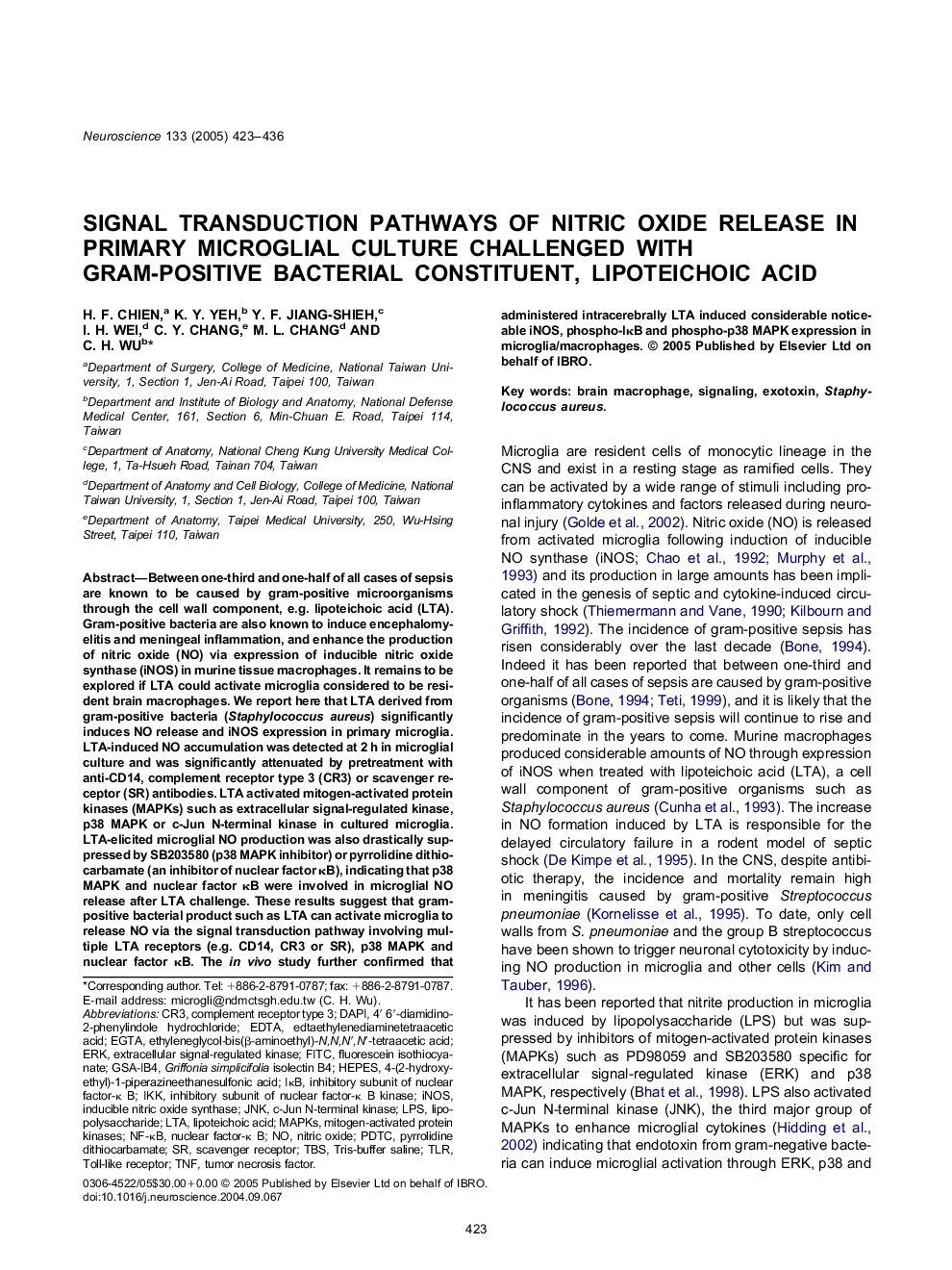| کد مقاله | کد نشریه | سال انتشار | مقاله انگلیسی | نسخه تمام متن |
|---|---|---|---|---|
| 9425408 | 1295869 | 2005 | 14 صفحه PDF | دانلود رایگان |
عنوان انگلیسی مقاله ISI
Signal transduction pathways of nitric oxide release in primary microglial culture challenged with gram-positive bacterial constituent, lipoteichoic acid
دانلود مقاله + سفارش ترجمه
دانلود مقاله ISI انگلیسی
رایگان برای ایرانیان
کلمات کلیدی
NF-κBnuclear factor-κ BTNFtris-buffer salinePDTCCR3LTAIKKTLRIκBDAPIiNOSERKTBSHEPESFITCLPSEGTAJnk4-(2-hydroxyethyl)-1-piperazineethanesulfonic acid - 4- (2-hydroxyethyl) -1-piperazineethanesulfonic acidc-Jun N-terminal kinase - C-Jun N-terminal kinaseMAPKs - MAPK هاEDTA - اتیلن دی آمین تترا استیک اسید Staphylococcus aureus - استافیلوکوک اورئوسlipoteichoic acid - اسید لیپتویکوئیکExotoxin - اگزوتوکسینToll-like receptor - تیالآرpyrrolidine dithiocarbamate - دی اتیل کربامات پیرولیدینinducible nitric oxide synthase - سنتاز اکسید نیتریک القاییSignaling - سیگنالینگtumor necrosis factor - فاکتور نکروز تومورfluorescein isothiocyanate - فلوئورسین ایسوتیوسیاناتlipopolysaccharide - لیپوپلی ساکاریدbrain macrophage - ماکروفاژ مغزcomplement receptor type 3 - نوع گیرنده مکمل 3Nitric oxide - نیتریک اکسیدextracellular signal-regulated kinase - کیناز تنظیم شده سیگنال خارج سلولیmitogen-activated protein kinases - کیناز پروتئین فعال MitogenScavenger receptor - گیرنده مخرب
موضوعات مرتبط
علوم زیستی و بیوفناوری
علم عصب شناسی
علوم اعصاب (عمومی)
پیش نمایش صفحه اول مقاله

چکیده انگلیسی
Between one-third and one-half of all cases of sepsis are known to be caused by gram-positive microorganisms through the cell wall component, e.g. lipoteichoic acid (LTA). Gram-positive bacteria are also known to induce encephalomyelitis and meningeal inflammation, and enhance the production of nitric oxide (NO) via expression of inducible nitric oxide synthase (iNOS) in murine tissue macrophages. It remains to be explored if LTA could activate microglia considered to be resident brain macrophages. We report here that LTA derived from gram-positive bacteria (Staphylococcus aureus) significantly induces NO release and iNOS expression in primary microglia. LTA-induced NO accumulation was detected at 2 h in microglial culture and was significantly attenuated by pretreatment with anti-CD14, complement receptor type 3 (CR3) or scavenger receptor (SR) antibodies. LTA activated mitogen-activated protein kinases (MAPKs) such as extracellular signal-regulated kinase, p38 MAPK or c-Jun N-terminal kinase in cultured microglia. LTA-elicited microglial NO production was also drastically suppressed by SB203580 (p38 MAPK inhibitor) or pyrrolidine dithiocarbamate (an inhibitor of nuclear factor κB), indicating that p38 MAPK and nuclear factor κB were involved in microglial NO release after LTA challenge. These results suggest that gram-positive bacterial product such as LTA can activate microglia to release NO via the signal transduction pathway involving multiple LTA receptors (e.g. CD14, CR3 or SR), p38 MAPK and nuclear factor κB. The in vivo study further confirmed that administered intracerebrally LTA induced considerable noticeable iNOS, phospho-IκB and phospho-p38 MAPK expression in microglia/macrophages.
ناشر
Database: Elsevier - ScienceDirect (ساینس دایرکت)
Journal: Neuroscience - Volume 133, Issue 2, 2005, Pages 423-436
Journal: Neuroscience - Volume 133, Issue 2, 2005, Pages 423-436
نویسندگان
H.F. Chien, K.Y. Yeh, Y.F. Jiang-Shieh, I.H. Wei, C.Y. Chang, M.L. Chang, C.H. Wu,